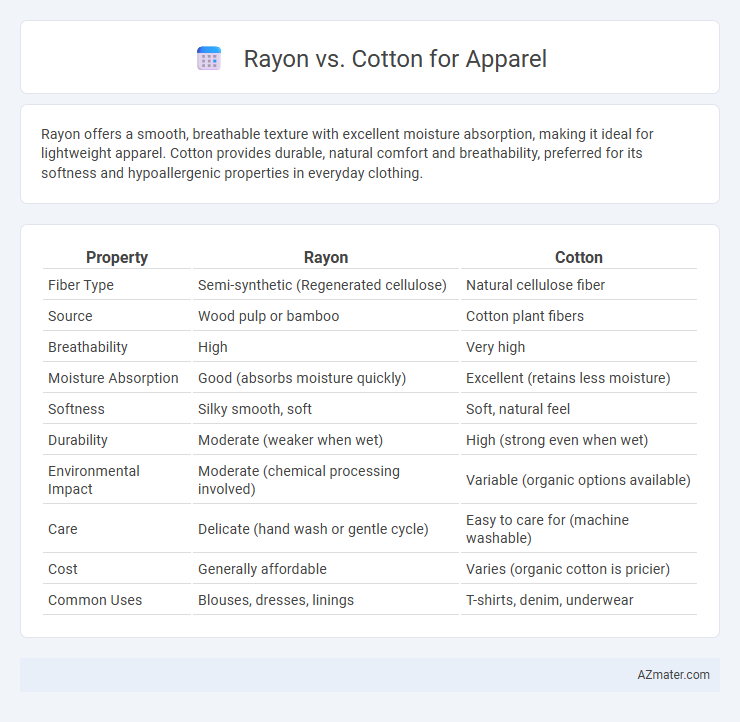Rayon offers a smooth, breathable texture with excellent moisture absorption, making it ideal for lightweight apparel. Cotton provides durable, natural comfort and breathability, preferred for its softness and hypoallergenic properties in everyday clothing.
Table of Comparison
| Property | Rayon | Cotton |
|---|---|---|
| Fiber Type | Semi-synthetic (Regenerated cellulose) | Natural cellulose fiber |
| Source | Wood pulp or bamboo | Cotton plant fibers |
| Breathability | High | Very high |
| Moisture Absorption | Good (absorbs moisture quickly) | Excellent (retains less moisture) |
| Softness | Silky smooth, soft | Soft, natural feel |
| Durability | Moderate (weaker when wet) | High (strong even when wet) |
| Environmental Impact | Moderate (chemical processing involved) | Variable (organic options available) |
| Care | Delicate (hand wash or gentle cycle) | Easy to care for (machine washable) |
| Cost | Generally affordable | Varies (organic cotton is pricier) |
| Common Uses | Blouses, dresses, linings | T-shirts, denim, underwear |
Introduction to Rayon and Cotton
Rayon is a semi-synthetic fiber made from regenerated cellulose, often derived from wood pulp, known for its smooth texture and breathability. Cotton is a natural fiber harvested from the seed hairs of cotton plants, valued for its softness, durability, and moisture-wicking properties. Both fibers are widely used in apparel due to their comfort and versatility, but they differ significantly in production processes and environmental impact.
Overview of Fabric Composition
Rayon is a semi-synthetic fiber made from regenerated cellulose derived primarily from wood pulp, offering a smooth and silky texture that mimics natural fibers. Cotton is a natural fiber harvested from the cotton plant's seed hairs, known for its breathability, softness, and durability. Fabric composition of rayon incorporates chemical processing for fiber production, while cotton maintains its natural, untouched structure, impacting moisture absorption and fabric strength in apparel.
Texture and Feel: Comfort Comparison
Rayon fabric offers a silky, smooth texture that feels lightweight and breathable against the skin, making it highly comfortable for warm weather apparel. Cotton provides a soft, natural feel with excellent moisture absorption, ideal for everyday wear and sensitive skin. Both materials excel in comfort, but rayon's smoothness contrasts with cotton's classic softness, allowing consumers to choose based on personal texture preference.
Breathability and Moisture Management
Rayon offers moderate breathability but excels in moisture-wicking due to its semi-synthetic cellulose fibers, making it suitable for light, breathable apparel. Cotton provides superior breathability and natural moisture absorption, ensuring comfort by allowing air circulation and keeping the skin dry. For activewear or humid climates, cotton's enhanced moisture management outperforms rayon, which may retain moisture and dry slower.
Durability and Longevity
Rayon offers a smooth, comfortable feel but tends to be less durable and prone to wear and shrinkage compared to cotton. Cotton, known for its strong fibers and excellent breathability, provides superior longevity and maintains integrity over multiple washes and uses. When prioritizing apparel durability, cotton is generally the preferred choice for long-lasting garments.
Care and Maintenance Requirements
Rayon apparel requires gentle care, including hand washing or delicate machine cycles with cold water, and air drying to prevent shrinkage and fabric weakening. Cotton garments are more durable, tolerating regular machine washing and higher temperatures, but may shrink if not pre-shrunk and benefit from ironing to remove wrinkles. Proper storage and avoiding harsh detergents extend the lifespan of both rayon and cotton fabrics in everyday wear.
Environmental Impact and Sustainability
Rayon production relies heavily on chemically intensive processes and large amounts of water, leading to deforestation and water pollution concerns, whereas cotton cultivation often demands significant pesticide use and vast water resources, especially in arid regions. Sustainable cotton practices such as organic farming reduce chemical inputs and conserve water, making it more eco-friendly compared to conventional cotton, though still resource-intensive. Bamboo-based rayon can offer a more sustainable option if produced through closed-loop processes that recycle chemicals and minimize environmental damage.
Cost and Affordability
Rayon is generally more affordable than cotton due to its semi-synthetic production process, which allows for mass manufacturing at lower costs. Cotton, being a natural fiber, often demands higher prices because of extensive agricultural labor and environmental factors influencing its yield. Consumers seeking budget-friendly apparel may prefer rayon for its cost-effectiveness while still maintaining a soft and breathable texture.
Suitability for Different Apparel Types
Rayon offers excellent drape and a smooth texture, making it ideal for flowing dresses, blouses, and linings in suits where softness and fluidity are prioritized. Cotton provides breathability and durability, suited for casual wear, shirts, and summer apparel requiring comfort and easy maintenance. Both fibers serve distinct apparel needs, with rayon favored for elegant, lightweight garments and cotton preferred in practical, everyday clothing.
Conclusion: Choosing Between Rayon and Cotton
Rayon offers a silky texture and excellent breathability, making it ideal for lightweight, drapey apparel, while cotton is durable, hypoallergenic, and easier to care for, perfect for everyday wear. The choice depends on garment purpose: opt for rayon in fashion-forward styles prioritizing comfort and elegance, or select cotton for long-lasting, casual, and practical clothing. Environmental impact and fabric maintenance also influence the decision; cotton's natural origin and easier washing provide sustainability advantages over rayon's synthetic processing.

Infographic: Rayon vs Cotton for Apparel
 azmater.com
azmater.com